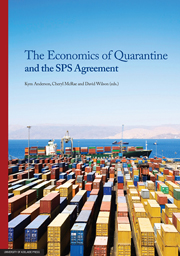Book contents
- Frontmatter
- Contents
- List of tables, figures and boxes
- Acronyms
- Preface
- List of contributors
- 1 Introduction
- PART I The multilateral rules under WTO
- 2 The integration of economics into SPS risk management policies: issues and challenges
- 3 The analytical foundation of quarantine risk analysis
- 4 The WTO dispute settlement framework and operation
- 5 Implications of recent SPS dispute settlement cases
- PART II The ‘appropriate level of protection’
- PART III Adding more economics to risk analysis
- PART IV Specific health and environmental risks from trade
- PART V Conclusion
- APPENDIX The legal text of the SPS Agreement
3 - The analytical foundation of quarantine risk analysis
from PART I - The multilateral rules under WTO
Published online by Cambridge University Press: 05 June 2013
- Frontmatter
- Contents
- List of tables, figures and boxes
- Acronyms
- Preface
- List of contributors
- 1 Introduction
- PART I The multilateral rules under WTO
- 2 The integration of economics into SPS risk management policies: issues and challenges
- 3 The analytical foundation of quarantine risk analysis
- 4 The WTO dispute settlement framework and operation
- 5 Implications of recent SPS dispute settlement cases
- PART II The ‘appropriate level of protection’
- PART III Adding more economics to risk analysis
- PART IV Specific health and environmental risks from trade
- PART V Conclusion
- APPENDIX The legal text of the SPS Agreement
Summary
Although people have always made decisions in the face of uncertainty, the ability to appreciate risk by specifically assessing probability and consequences is a particular characteristic of modern times. The ability to consider what may happen in the future and to choose rationally between options is essentially a modern phenomenon that has its historical roots in the mathematics of risk-taking, particularly of gambling, insurance and financial investment (Bernstein 1997). The understanding of risk and rational risk-taking that has developed from these roots through risk analysis underpins the modern market economy, including international trade. This paper explores the analytical foundation of the analysis of risks associated with importing animals and plants or their products1 as used by quarantine authorities to develop sanitary and phytosanitary measures to mitigate the spread of disease.
Risk analysis has been recognised only recently as a formal discipline in its own right and there is still some confusion in both scientific and popular literature about the precise definition of each of its elements (Krewski and Birkwood 1987; Covello and Merkhofer 1993; Byrd and Cothern 2000). Several attempts have been made to develop a standardised nomenclature in a range of disciplines – including animal health, plant health, food safety, and environmental science (Nunn 1997). However, some authorities use ‘risk management’ rather than ‘risk analysis’ for the overall term (e.g. SA/SNZ 1999) and others restrict ‘risk analysis’ to include elements such as risk identification, assessment and evaluation but not risk management and risk communication.
- Type
- Chapter
- Information
- The Economics of Quarantine and the SPS Agreement , pp. 29 - 52Publisher: The University of Adelaide PressPrint publication year: 2012
- 4
- Cited by

